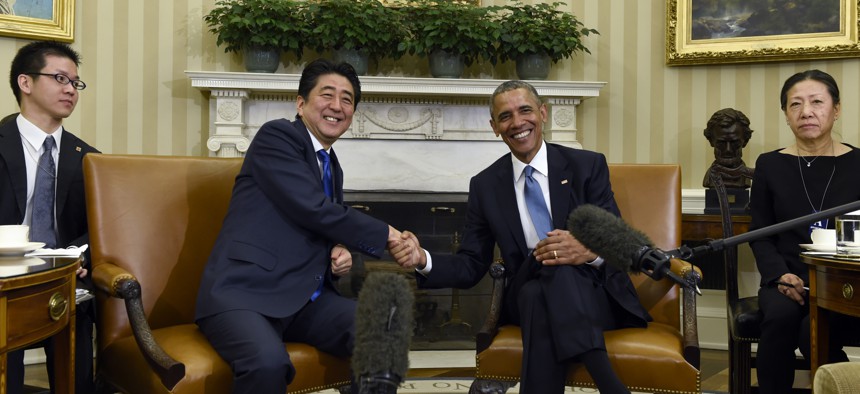
President Barack Obama shakes hands with Japanese Prime Minister Shinzo Abe during their meeting in the Oval Office of the White House in Washington, Tuesday, April 28, 2015. Susan Walsh/AP
Four Key Areas for Japan-US Military Cooperation
While the new agreement most directly shores up defenses against North Korea, it could also help counterbalance a rising China.
U.S. President Barack Obama and Japanese Prime Minister Shinzo Abe are pledging to deepen military cooperation in the coming years as America reinforces its pivot to the Asia-Pacific region.
The most fundamental shift in military relations between the two countries rests in the agreement to come to the defense of either nations’ troops should they come under threat from an adversary in the region. While this is widely regarded to protect against the North Korean threat in particular, U.S. officials this week downplayed the renewed alliance’s possible counterbalance to China’s expansive regional maritime ambitions.
Here are four other key areas where the two countries plan to strengthen cooperation:
Air and Maritime
The Pentagon is already deploying high-end equipment to Japan and plans to continue sending its most advanced equipment to the Pacific. The Marine Corps is sending its new F-35 Joint Strike Fighters there in 2017. And Navy patrol and intelligence planes have been staged in Japan for years, along with Air Force Global Hawk drones. Later this year, the Navy will bring home the aircraft carrier currently homeported at Yokosuka, USS George Washington, and replace it with the newer, more advanced USS Ronald Reagan.
Cyber and Space
Washington and Tokyo are both looking to protect commercial interests that help secure Japan’s place as the world’s third-largest economy. Many of those interests experienced a big shock late last year when North Korean hackers infiltrated Sony Pictures networks in December. The hack showed that poor and heavily sanctioned nation-states can nonetheless cause a bit of online havoc.
To that end, the U.S. and Japan promised to hold talks later this year on cyber cooperation and how to best protect what the White House calls the “Internet Economy.” The two nations also vowed to share more information on cyber espionage and “voluntary norms of state behavior in cyberspace during peacetime,” the lack of which remains perhaps the largest hurdle to arriving at an international consensus on this new model of both warfare and eavesdropping on enemies as well as allies.
American and Japanese also pledged to “strengthen the resilience and interoperability of critical space systems.” What that means is that the two nations will double-down on joint projects involving space-based positioning, navigation and timing; tracking objects in space; using satellites to track ships; research and development in space technologies; and using multiple payloads on a single satellite.
Missile Defense and Nuclear
The U.S. plans to deploy two additional Navy ballistic missile destroyers to Japan by 2017, and late last year deployed a second AN/TPY-2, a long-range radar that tracks ballistic missiles. The U.S. has spent the last few years beefing up its missile defenses in Japan to counter North Korean missiles. (That concern is shared by South Korea, which is eyeing a U.S. missile defense system that could shake up the regional security dynamics as well.)
Washington and Tokyo also vowed to closely monitor nuclear states across the globe so that their energy programs do not contribute to the spread of nuclear weapons. The enhanced partnership also promises a joint U.S.-Japan response should nation-states fail to comply with nuclear security standards laid out by the International Atomic Energy Agency.
Ground Forces
Japan is stepping into African peacekeeping operations, joining dozens of nations that already have a similar presence on the continent. Just last week, Abe returned from the Asian-African Summit held in Jakarta, where he promised a firm response to terrorism and infectious diseases like Ebola. The White House also signaled Japan’s increased involvement in the U.S. African Peacekeeping Rapid Response Partnership, a security and development effort involving Africa Command and some 70,000 African Union and UN peacekeepers from 22 different nations on the continent.
NEXT STORY: The Bipartisan Bedfellows Behind the Iran Bill



